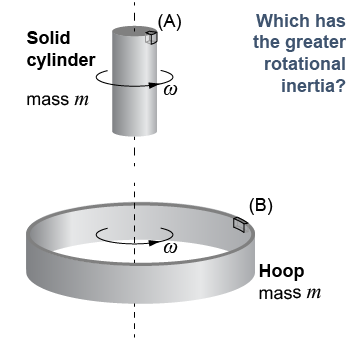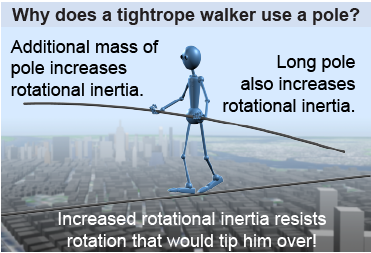|
 An object’s rotational inertia is its resistance to changing its state of rotation—increasing or decreasing its angular velocity. A wheel with low rotational inertia is easy to spin. An amusement-park Ferris wheel starts and stops very slowly because the heavy steel structure has a large rotational inertia. Racing cars and bicycles have very light aluminum-alloy wheels to reduce rotational inertia.
An object’s rotational inertia is its resistance to changing its state of rotation—increasing or decreasing its angular velocity. A wheel with low rotational inertia is easy to spin. An amusement-park Ferris wheel starts and stops very slowly because the heavy steel structure has a large rotational inertia. Racing cars and bicycles have very light aluminum-alloy wheels to reduce rotational inertia. 
|
 Rotational inertia depends not only on mass and rotational speed but also on how mass is distributed around the axis of rotation. Consider a solid cylinder and a hoop with the same mass m rotating at the same angular velocity ω. Now think about a small element of mass inside each object. Mass element (B) is moving faster than mass element (A) because point (B) is farther from the axis of rotation than point (A). A hoop has more rotational inertia than a cylinder of equal mass at the same angular velocity because the mass in the hoop is moving faster because of its greater distance from the axis of rotation.
Rotational inertia depends not only on mass and rotational speed but also on how mass is distributed around the axis of rotation. Consider a solid cylinder and a hoop with the same mass m rotating at the same angular velocity ω. Now think about a small element of mass inside each object. Mass element (B) is moving faster than mass element (A) because point (B) is farther from the axis of rotation than point (A). A hoop has more rotational inertia than a cylinder of equal mass at the same angular velocity because the mass in the hoop is moving faster because of its greater distance from the axis of rotation. 
|
The quantity of rotational inertia possessed by an object called its moment of inertia and is identified with a capital letter “I” in equation (13.1). The units of I are kg m2. Notice that the moment of inertia varies with the square of the radius. That means that mass that is twice as far from the center of rotation contributes four times as much rotational inertia. 
|
| (13.1) | | | I | = | moment of inertia (kg m2) | | m | = | mass (kg) | | r | = | radius (m) |
| Moment of inertia
of a point mass |
|

|
To get a sense of how mass distribution changes rotational inertia, consider a light wooden pole with two 1 kg iron masses. When the masses are 0.1 m from the center, the moment of inertia is 0.02 kg m2. When the masses are 1.0 m from the center, the moment of inertia is a hundred times larger, even though the total mass is identical! Consequently, it takes a hundred times more torque to change the rotational speed when the masses are spread out. 
 |
 What is the trick of walking a tightrope without falling off? The pole! Both the added mass and the length of the pole increase the tightrope walker’s rotational inertia. When holding the pole, much more torque is required to rotate the walker in such a way that would knock him off the rope. For the same reason, gymnasts will stick their arms out to make a “balance check.”
What is the trick of walking a tightrope without falling off? The pole! Both the added mass and the length of the pole increase the tightrope walker’s rotational inertia. When holding the pole, much more torque is required to rotate the walker in such a way that would knock him off the rope. For the same reason, gymnasts will stick their arms out to make a “balance check.” 
|
A professional cyclist is designing his ideal bicycle for racing. Should he make the rims of his wheels heavy or light? Use the rotational properties of the wheel in your answer.
 |
He should use wheel rims that are as light as possible, because they will have the least rotational inertia. Wheels with less rotational inertia will require less torque (applied by the pedals to the chain and axle) to spin when the cyclist is accelerating. 
|

